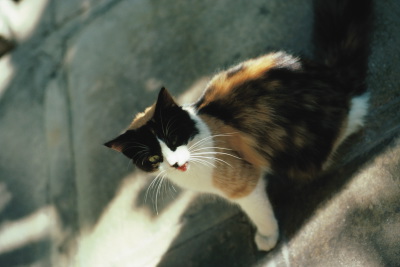Aggie Cat Society helps campus feral cats
More than 55 feral cats roam campus, estimated Ilona Jappinen, a former USU professor. The Aggie Cat Society is looking for volunteers to feed the felines on campus (Statesman photo). The Aggie Cat Society met last Tuesday night to discuss what their plans were for controlling the feral cat population both on campus and throughout Cache Valley. The meeting stressed the need for more volunteers to help feed the cats on campus, as well as neighborhood volunteers in the Bridger and Woodruff areas to conduct community education on responsible ownership of cats.
The National Humane Society estimates that the numbers of feral cats runs into the tens of millions. They live in every environment that humans can live in, whether it’s urban, rural or metropolitan areas. Ilona Jappinen, a former USU professor, estimated that the feral cat population in Cache Valley most likely runs in the thousands, with more than 55 feral cats on the USU campus.
The current policy in most areas of the U.S. is to capture and euthanize all feral cats. However, many areas have started a capture and spay or neuter release program to help control the population of feral cats. Many of these areas have seen great success with this method, some of them seeing 100 percent drops in the feral cat population.
Logan City is still using a capture and euthanize approach to feral cats and spent more than $39,000 last year capturing and euthanizing feral cats. Despite the high costs, there has not been a noticeable drop in the population, because when one cat leaves an environment, another one usually enters. Without spaying or neutering feral cats, there is essentially no way to control the population.
Feral cats in environments that aren’t managed live a painful life. There is a 75 percent mortality rate for feral kittens, and adult feral cats have an average lifespan of only two years, compared to the house cat lifespan of 12 to 20 years. Much of the feral cat population in the Cache Valley stemmed from people abandoning their cats when they move or when they are simply sick of taking care of them.
Jappinen said, “Abandoning your cat is akin to murdering it. The cat will eventually have a very unpleasant death.”
The Aggie Cat Society is calling upon volunteers to feed the feral cat population at USU. There are six feeding stations to help the 55 feral cats on campus survive. Volunteers feed the cats at the stations at 5 p.m. every day, and it takes about 45 minutes. The society is looking for anyone who can do it at least once a week.
Everyone is welcome to see some of the cats on campus. It is easiest to go outside the Junction at 5 p.m., where about 12 cats come every night. To volunteer, donate money or find more information on the Aggie Cat Society, visit www.usu.edu/aggiecats.

